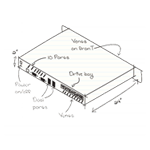Silkscreening
- Also known as screen-printing or serigraphy, it is a printing technique that involves passing ink through a porous fabric, thus creating a sharp-edged single-color image created from a stencil.
- Utilizes the latest in screen-preparation technology, as well as durable epoxy based inks, to ensure a high resolution and quality finish.
- We stock a variety of standard silkscreen ink colors, and can provide custom colors upon request (see below).
- You may silkscreen graphics onto enclosures, parts and panels that either have bare-metal finish or powder coat finish.
Additional Information
Using Powder Coat?
The clarity of silkscreen can be greatly affected by the texture of powder coat used. Generally, for best results, it is recommended you choose a smooth powdercoat finish. Silkscreen will work on various textures and colors but each situation is unique. This may require modifications to your silkscreen such as changing of fonts and thickening of fine lines.
For more information, please contact tech support at info@protocase.com.
Image File Requirements
Image files must be provided electronically. Faxed images will not provide sharp enough resolution for our process to replicate. If text-only screening is required, simply provide information such as font type, font size and font color when you submit your order. Our graphics team will be happy to produce the required text-only screens.
Font Sizes
Minimum 9 pt font size required, with the exception of silkscreening over sandtex powdercoat, which requires a minimum 11 pt font size.
Graphic File Formats
Vector graphic files are recommended for highest print quality and clarity:
.AI - Adobe Illustrator
.EPS - Encapsulated PostScript
.SVG - Scalable Vector Graphics
.PDF - Portable Document Format
.DXF or .DWG - AutoCAD
We can accept the following raster image files (additional processing charges may apply):
.PNG - Portable Network Graphic
.JPG (.JPEG) - Joint Photographic Experts Group
.TIF (.TIFF) - Tagged Image File
.PSD - Photoshop
.VDX, .VSD, or .VSDX - Visio
.DOCX - Microsoft Word
.PPTX - Microsoft PowerPoint
File formats we cannot accept:
.CDR - Corel Draw File
Silkscreening Samples
Stocked Silkscreening Colors
The color representations below may deviate from the actual color due to variations in browser software, video cards and monitors.
High Intensity White
Lemon Yellow, Epoxy Ink
Pantone 123C Medium Yellow
Pantone 142C, Epoxy Ink
Pantone 6C Cool Gray
Brilliant Orange, Epoxy Ink
Fire Red, Epoxy Ink
Pantone 201C, Epoxy Ink
Pantone 649C, Epoxy Ink
Pantone Process BlueC
Pantone 355C, Epoxy Ink
Pantone 2623C (Purple)
Opaque Black, Epoxy Ink
Pantone Cool Gray 10C
Proto-Reflex Blue
Pantone 3285C, Epoxy Ink
We can provide custom silkscreen colors upon request. Contact us to share your requirements.
Cleaning Your Enclosures & Parts
We recommend any part or enclosure with digital print or silkscreen be cleaned using a mild soap/degreaser (for example: dish detergent), or water with a soft (non-abrasive) cloth or sponge.
Avoid using isopropyl alcohol, lysol wipes, acetone or hand sanitizer. For cloths, we do not recommend paper towel, as it is abrasive.
Tolerances
As with everything in the manufacturing process, there are always some variance between parts and images (spatial registration). We use an X,Y and angular micro-adjust, which allows for a respectable tolerance of 0.020" | 0.51mm, which is more than adequate for most applications.
However, there are certain situations that are much more sensitive to disparation. Please see diagrams below for examples.
Figure 1 - Eccentric Circles: Left 0.020" (0.50mm) eccentricity x & y, middle 0.002" (0.05mm) x & y, Right 0.010" (0.25mm) eccentricity x & y
NOTE: Images are a scaled representation of a CAD drawing of half-inch circles around quarter-inch holes.
NOTE: We strive for excellence with the goal of reducing Foreign Object Debris (FOD) and achieving consistency with all silkscreening. However, due to some constraints of our facility, there may be minor blemishes on parts. These blemishes are not distinguishable or seen from an arm's length away.
Get Started

NEED DESIGN HELP?
Our experts can design your custom enclosures exactly as you want them.




